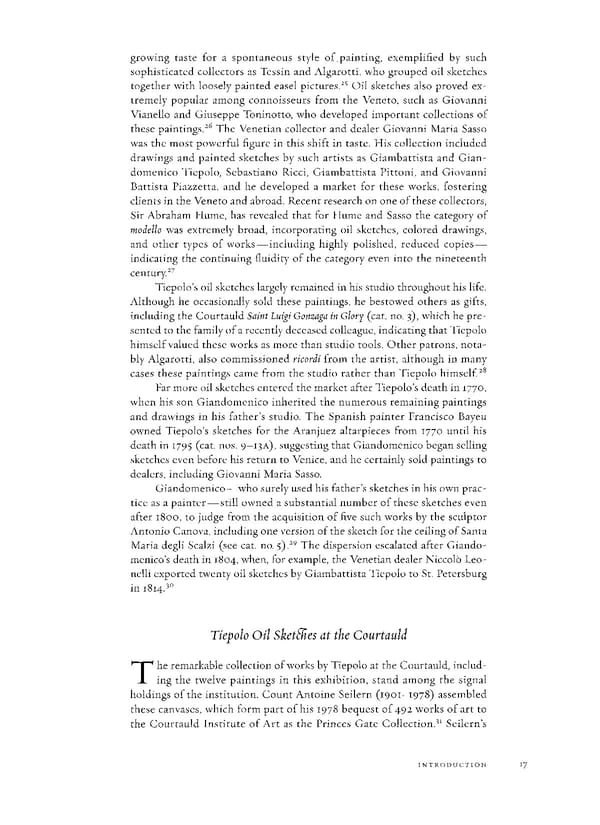growing taste for a spontaneous style of, painting, exemplified by such sophisticated collectors as Tessin and Algarotti, who grouped oil sketches 25 together with loosely painted easel pictures. Oil sketches also proved ex- tremely popular among connoisseurs from the Veneto, such as Giovanni Vianello and Giuseppe Toninotto, who developed important collections of 26 these paintings. The Venetian collector and dealer Giovanni Maria Sasso was the most powerful figure in this shift in taste. His collection included drawings and painted sketches by such artists as Giambattista and Gian- domenico Tiepolo, Sebastiano Ricci, Giambattista Pittoni, and Giovanni Battista Piazzetta, and he developed a market for these works, fostering clients in the Veneto and abroad. Recent research on one of these collectors, Sir Abraham Hume, has revealed that for Hume and Sasso the category of modello was extremely broad, incorporating oil sketches, colored drawings, and other types of works—including highly polished, reduced copies — indicating the continuing fluidity of the category even into the nineteenth 27 century Tiepolo's oil sketches largely remained in his studio throughout his life. Although he occasionally sold these paintings, he bestowed others as gifts, including the Courtauld Saint Luigi Gonzaga in Glory (cat. no. 3), which he pre- sented to the family of a recently deceased colleague, indicating that Tiepolo himself valued these works as more than studio tools. Other patrons, nota- bly Algarotti, also commissioned ricordi from the artist, although in many cases these paintings came from the studio rather than Tiepolo himself28 Far more oil sketches entered the market after Tiepolo's death in 1770, when his son Giandomenico inherited the numerous remaining paintings and drawings in his father's studio. The Spanish painter Francisco Bayeu owned Tiepolo's sketches for the Aranjuez altarpieces from 1770 until his death in 1795 (cat. nos. 9—13A), suggesting that Giandomenico began selling sketches even before his return to Venice, and he certainly sold paintings to dealers, including Giovanni Maria Sasso. Giandomenico—who surely used his father's sketches in his own prac- tice as a painter — still owned a substantial number of these sketches even after 1800, to judge from the acquisition of five such works by the sculptor Antonio Canova, including one version of the sketch for the ceiling of Santa 29 Maria degli Scalzi (see cat. no. $). The dispersion escalated after Giando- menico's death in 1804, when, for example, the Venetian dealer Niccolo Leo- nelli exported twenty oil sketches by Giambattista Tiepolo to St. Petersburg in i8i4.3° Tiepolo Oil Sket&es at the Courtauld The remarkable collection of works by Tiepolo at the Courtauld, includ- ing the twelve paintings in this exhibition, stand among the signal holdings of the institution. Count Antoine Seilern (1901-1978) assembled these canvases, which form part of his 1978 bequest of 492 works of art to 31 the Courtauld Institute of Art as the Princes Gate Collection. Seilern's INTRODUCTION YJ
 Giambattista Tiepolo: Fifteen Oil Sketches Page 17 Page 19
Giambattista Tiepolo: Fifteen Oil Sketches Page 17 Page 19